I am excited to share with you the mesmerizing wonders of coral spawning dives and the best time to experience this extraordinary phenomenon. Coral spawning dives offer a breathtaking spectacle that showcases nature’s marvels in the underwater world. To witness this incredible display, it is essential to know when and where to embark on your coral spawning diving adventure.
Key Takeaways:
- Coral spawning dives offer a captivating display of nature’s wonders.
- The best time for coral spawning dives depends on factors such as the lunar cycle and water temperature.
- The timing of coral spawning usually occurs a few nights after the full moon, during specific months when the water temperature is warmer.
- Coral spawning dives are best experienced in popular diving destinations such as the Great Barrier Reef, the Maldives, and the Caribbean.
- To maximize your chances of witnessing this phenomenon, dive with experienced operators, plan night dives, and book in advance.
Understanding Coral Spawning
Coral spawning is a fascinating reproductive process where corals release their eggs and sperm simultaneously, creating a mesmerizing cloud-like display in the water. This natural phenomenon is essential for the reproduction and survival of coral reefs, contributing to their biodiversity and growth.
The timing of coral spawning is influenced by various factors, including the lunar cycle, water temperature, and time of year. Researchers have conducted extensive studies to understand this intricate process and its connection to environmental conditions.
Studies suggest that coral spawning typically occurs a few nights after the full moon, during specific months when the water temperature is warmer. These favorable environmental conditions signal corals to synchronize their reproductive efforts, resulting in magnificent displays that attract divers and marine enthusiasts from around the world.
To give you a better understanding of coral spawning, here is an overview of the key factors that influence this remarkable event:
- Lunar Cycle: The lunar cycle plays a crucial role in coral spawning. Many coral species release their eggs and sperm during specific phases of the moon, commonly a few nights after the full moon. This timing allows for optimal fertilization and increases the chances of successful reproduction.
- Water Temperature: Coral spawning is closely connected to water temperature. Warmer water temperatures trigger corals to release their reproductive cells, as the elevated temperatures provide favorable conditions for fertilization and the development of coral larvae. Specific months with warmer water temperatures are often the prime time for coral spawning.
- Time of Year: The exact time of year when coral spawning occurs can vary depending on the location and the species of corals. However, it is generally associated with the spring and summer seasons, when water temperatures are higher worldwide. These months provide the ideal conditions for corals to engage in their reproductive cycle.
By understanding these environmental factors, scientists and divers can anticipate and plan for coral spawning events. The precise timing varies across different locations and species, making it an awe-inspiring yet unpredictable spectacle.
“Coral spawning is nature’s breathtaking display of reproductive synchrony, showcasing the resilience and beauty of these remarkable ecosystems.” – Marine Biologist
Witnessing coral spawning firsthand is a truly unforgettable experience. The dynamic dance of corals as they release their gametes into the water creates an ethereal atmosphere, illustrating the intricate interconnectedness of marine life.
Relevance to Coral Reefs
Coral spawning is an essential process for coral reef ecosystems. It promotes genetic diversity, allowing corals to adapt and withstand environmental stressors. It also aids in the dispersal and settlement of coral larvae, contributing to the growth and expansion of reefs.
| Benefits of Coral Spawning | Importance |
|---|---|
| Enhances genetic diversity | Promotes adaptability and resilience |
| Aids in reef recovery | Supports the growth and expansion of coral reefs |
| Facilitates the dispersal and settlement of coral larvae | Contributes to reef connectivity |
Understanding the reproductive cycle of corals and the environmental conditions necessary for successful coral spawning enables scientists, conservationists, and divers to protect and preserve these delicate ecosystems. By responsibly enjoying coral spawning dives, we can appreciate the wonders of nature while actively contributing to the conservation of coral reefs.
Best Time for Coral Spawning Dives
The best time for coral spawning dives varies depending on the location and specific coral species. In general, coral spawning tends to occur during warmer months, typically in the spring and summer. Many popular diving destinations, such as the Great Barrier Reef in Australia, the Maldives, and the Caribbean, offer opportunities to witness coral spawning between the months of November and February. However, it is crucial to note that the exact timing can vary within this range and is influenced by the lunar cycle. Divers should plan their trips around the full moon, as coral spawning often takes place a few nights after the full moon.
During the warmer months, corals are more active and prepared for reproduction. The increased water temperature prompts corals to synchronize their spawning efforts, creating a magnificent display underwater. As the temperature rises, the metabolic activity of corals speeds up, leading to the simultaneous release of eggs and sperm.
It is also important to consider the lunar cycle when planning a coral spawning dive. Research suggests that corals prefer to release their eggs and sperm during specific phases of the lunar cycle, typically occurring a few nights after the full moon. The lunar cycle plays a significant role in triggering this natural phenomenon, as corals rely on the moon’s light to coordinate their reproductive behavior.
If you want to witness coral spawning dives, it is essential to choose a diving location and time of year that aligns with these factors. By planning your dive during the warmer months and around the full moon, you increase your chances of experiencing this mesmerizing event firsthand.

During coral spawning dives, the water comes alive with the vibrant colors of countless coral polyps releasing their eggs and sperm. This breathtaking display of nature’s marvels is an opportunity to witness the cycle of life in the underwater world.
Tips for Witnessing Coral Spawning
When it comes to witnessing coral spawning, there are a few tips that can increase your chances of experiencing this awe-inspiring event. Here are some important factors to consider:
1. Dive with Experienced Operators
Choosing the right dive operator is crucial for a successful coral spawning dive. Look for operators who have extensive knowledge about the local conditions and the timing of coral spawning in the area. Their expertise will greatly enhance your chances of being in the right place at the right time.
2. Opt for Night Dives
Night dives are typically the best time to observe coral spawning. Many corals release their eggs and sperm after sunset, creating a mesmerizing display illuminated by underwater flashlights. The darkness adds to the magical ambiance, making night dives an unforgettable experience.
3. Book in Advance
As coral spawning is a highly anticipated event among divers, it is essential to book your dives in advance. The peak coral spawning season attracts numerous enthusiasts, and dive spots can fill up quickly. By securing your booking ahead of time, you ensure that you won’t miss out on this incredible underwater spectacle.
4. Practice Responsible Diving
While witnessing coral spawning is undoubtedly fascinating, it is crucial to remember that these delicate ecosystems require our protection. During this critical time for their reproduction, it is essential to practice proper underwater etiquette. Avoid touching or disturbing the corals, as they are vulnerable during the spawning process.
“Dive with experienced operators who know the local conditions and timing of coral spawning to increase your chances of witnessing this breathtaking phenomenon.” – Expert Diver
By following these tips, you can maximize your chances of witnessing the captivating event of coral spawning. Dive with experienced operators, embrace the darkness of night dives, book in advance, and observe responsible diving practices. Prepare to be mesmerized as you immerse yourself in the wonders of nature beneath the surface.
| Tips for Witnessing Coral Spawning |
|---|
| Dive with experienced operators |
| Opt for night dives |
| Book in advance |
| Practice responsible diving |

Conclusion
Embarking on coral spawning dives is a truly extraordinary experience that allows you to witness the captivating marvels of marine life and the intricate process of coral reproduction. By understanding the key factors that influence coral spawning, such as the lunar cycle and water temperature, you can strategically plan your trips to increase your chances of encountering this mesmerizing event.
When diving during the ideal months, typically in the spring and summer, and around the full moon, you’ll have the best opportunities to witness nature’s spectacular display. It is crucial to select reputable dive operators who are well-versed in the local conditions and timing of coral spawning. Booking your dives in advance is essential, as these once-in-a-lifetime experiences tend to fill up quickly during the peak coral spawning season.
Furthermore, responsible diving practices are of utmost importance during this critical time for coral reproduction. Ensuring the preservation of these delicate ecosystems is vital, so remember to avoid touching or disturbing the corals. By doing so, you contribute to the long-term sustainability and protection of these breathtaking underwater worlds, allowing future generations to continue enjoying the wonders of coral spawning dives.
Intrigued by the secrets of coral spawning? Prepare to be amazed as you dive into the underwater world and bear witness to nature’s extraordinary spectacle unfolding before your very eyes. Brace yourself for the awe-inspiring beauty and immense diversity that awaits you during these coral spawning dives.
FAQ
What is coral spawning?
Coral spawning is the reproductive process where corals release their eggs and sperm simultaneously, creating a cloud-like display in the water.
What factors influence the timing of coral spawning?
The timing of coral spawning is influenced by the lunar cycle, water temperature, and time of year.
When is the best time for coral spawning dives?
The best time for coral spawning dives varies depending on the location and specific coral species. In general, it tends to occur during warmer months, typically in the spring and summer.
Which months offer opportunities to witness coral spawning?
Many popular diving destinations, such as the Great Barrier Reef in Australia, the Maldives, and the Caribbean, offer opportunities to witness coral spawning between the months of November and February.
How can I increase my chances of witnessing coral spawning?
To increase your chances, it is recommended to dive with experienced operators who are familiar with the local conditions and timing of coral spawning. Night dives are typically the best time for observing this phenomenon.
Should I book my dives in advance?
Yes, it is essential to book your dives in advance, as spots can fill up quickly during the peak coral spawning season.
What should I keep in mind during coral spawning dives?
Divers should practice proper underwater etiquette and avoid touching or disturbing the corals during this crucial time for their reproduction.
Why should I choose reputable dive operators?
Choosing reputable dive operators ensures that you have knowledgeable guides who are familiar with the local conditions and can provide a safe and responsible diving experience.
